2 October 2013
PDF version [232KB]
Martin Lumb
Politics and Public Administration Section
Contents
Introduction
Composition of the 43rd Parliament
Gender
Ethnic background
Age
Qualifications
Occupational background
Movement between parliaments
Length of service
Comparisons with other countries
Conclusion
In recent years, academics and media commentators have documented the rise of a professional political class and the apparent shrinking gene pool in parliament, where members of Parliament often have ‘more in common with each other than with many of their constituents’.[1] This Research Paper examines the biographical details of the senators and members of the 43rd Parliament, and draws on the statistical tables featured in the 32nd edition of the Parliamentary Handbook of the Commonwealth of Australia.[2] The paper focuses on the age, qualifications, previous employment and length of parliamentary service, and compares these characteristics with previous parliaments. A similar examination of the 41st Parliament was published in 2006.[3]
The 21 August 2010 election saw 29 new members elected to the House of Representatives, together with the return of three Coalition members who did not retain their seats at the 2007 election, Warren Entsch (LIB, Leichhardt, Qld), Teresa Gambaro (LIB, Brisbane, Qld) and Ross Vasta (LIB, Bonner, Qld). This new component constituted approximately 20 per cent of the chamber. This compares with 39 new House of Representatives members at the 2007 election (26 per cent of the chamber). Of the 32 members who left the House at the 2010 election, 20 retired and 12 were defeated.
Of the 40 senators up for re-election in 2010, all but 12 were re-elected. Six did not contest the election and six were defeated. The 12 new senators, including David Fawcett (LIB, SA) the former Member for Wakefield from 2004 to 2007, equated to approximately 16 per cent of the chamber, compared with 14 new Senators (18 per cent) after the 2007 election.
The statistics and tables in this paper are based on data for the 43rd Parliament as at 1 July 2011 when the new senators commenced their term. Party representation for the two chambers is detailed in Table 1 below. During the course of the Parliament, there have been seven casual vacancies in the Senate, but no House of Representatives by-elections. Although party numbers remained the same in the Senate from 1 July 2011, some variations occurred in the House of Representatives. Bob Katter (Kennedy, Qld) announced the launch of his own party, and was formally listed as Katter’s Australian Party from 27 September 2011. Peter Slipper (Fisher, Qld) resigned from the Liberal Party and became an independent on 24 November 2011. Craig Thomson (Dobell, NSW) resigned from the Australian Labor Party and became an independent on 29 April 2012. Tony Crook (O’Connor, WA) sat as an independent until 8 May 2012, and subsequently sat with The Nationals, but did not attend joint Coalition meetings.
Table 1. Party representation in the 43rd Parliament
House of Representatives
| Party |
Pre-election
|
Post-election
|
| Australian Labor Party |
83
|
72
|
| Liberal Party of Australia |
54
|
60
|
| The Nationals/Country Liberal Party |
9
|
12
|
| Coalition |
63
|
72
|
| The Nationals (WA) |
–
|
1
|
| Australian Greens |
–
|
1
|
| Independent |
4
|
4
|
| Total |
150
|
150
|
Senate
| Party |
before July 2011
|
after July 2011
|
| Australian Labor Party |
32
|
31
|
| Liberal Party of Australia |
32
|
28
|
| The Nationals/Country Liberal Party |
5
|
6
|
| Coalition |
37
|
34
|
| Australian Greens |
5
|
9
|
| Family First |
1
|
–
|
| Democratic Labour Party |
–
|
1
|
| Independent |
1
|
1
|
| Total |
76
|
76
|
Following the 2010 election, the number of women in Parliament declined slightly from 68 to 67, approximately 30 per cent of the Parliament.[4] The number of women in the House of Representatives declined from 41 (27 per cent) to 37 (25 per cent). When the newly-elected Senators commenced on 1 July 2011, the number of women in the Senate rose from 27 (35 per cent) to 30 (38 per cent). This higher proportion of women in the upper house is mirrored in Australian state parliaments. In the five states with upper houses, four (NSW, WA, SA and Tas) currently have a higher proportion of women in the upper house than the lower house, Victoria the only exception.[5]
Although detailed research on the ethnic background of the Parliament is limited, some indications can be drawn from Parliamentary Handbook statistics on the number of overseas born MPs. Nearly half of the members of the first Parliament (49 per cent) were born overseas, predominantly the United Kingdom. In the 43rd Parliament only 12 per cent were born overseas. Of the 29 senators and members born overseas, 13 were born in the United Kingdom; four in New Zealand; and one each from Belgium, Canada, France, Germany, Greece, Hungary, Ireland, Italy, Malaysia, the Netherlands, Nigeria and South Africa.[6] Place of birth, of course, does not necessarily reflect ethnic background. Additional research indicates that at least 13 per cent of the 43rd Parliament were migrants from a non-English speaking background or children of migrants from a non-English speaking background.[7] Ken Wyatt (LIB, Hasluck, WA), elected in 2010, became the first Indigenous member of the House of Representatives.
Parliament remains the domain of the middle-aged: the number of members in the 40–59 age bracket in the 43rd Parliament was 159, with only 26 (11.5 per cent) younger than 40, and 41 (18.1 per cent) aged 60 or older.
The youngest parliamentarian in the 43rd Parliament was Wyatt Roy (LIB, Longman, Qld), also the youngest ever elected to Parliament—he was 20 when elected in 2010. The oldest member of the 43rd Parliament was Alby Schultz (LIB, Hume, NSW), 71 when re-elected in 2010. Mr Schultz did not contest the 2013 election.
Figure 1. Total MPs in each age bracket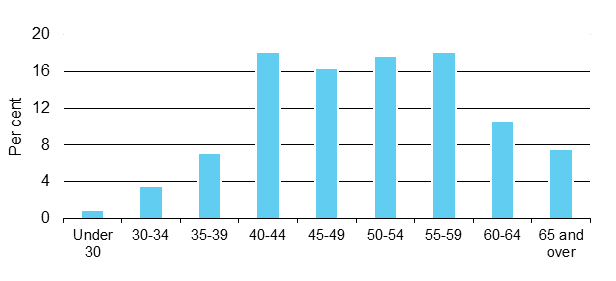
The average age was 51, slightly older than the previous parliament (50.1), but comparable with historical statistics. Since Federation, the average age of senators and members in any one Parliament has ranged between 47 and 52, fluctuating from 48.1 in 1901 to 51.8 in 1950 and down to 47.5 in 1978.[8] The difference between the two chambers in the 43rd Parliament was marginal: the average age of those in the Senate was 51.7 while the average age of those in the House was 50.6. Figure 2 illustrates the similarity in age distribution across both chambers, except for a peak in the 50–54 age bracket in the Senate not seen in the House.
Figure 2. Age of MPs (percentage), by chamber 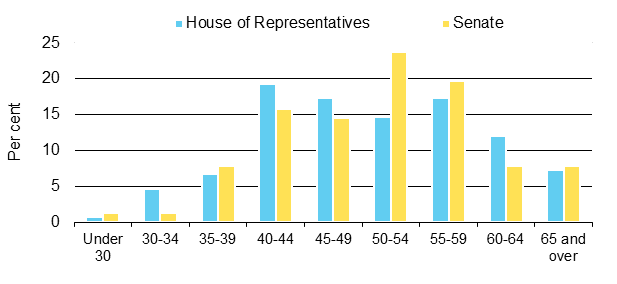
Figure 3 shows that the largest difference between the parties occurs in the over 65 age bracket. The Coalition has 14 senators and members over the age of 65, while the ALP has none.
Figure 3. Age of MPs (percentage), by party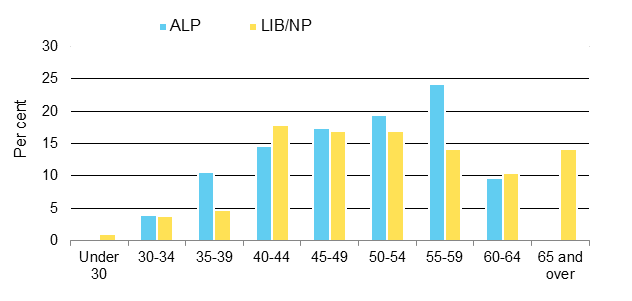
The number of MPs with post-secondary qualifications has risen steadily since Federation: from approximately 15 per cent in 1901 to 41 per cent in 1980[9], and now nearly 81 per cent (183 out of 226).[10] There was a slight difference between the chambers: 84 per cent of the senators and 79 per cent of the members of the House of Representatives had post-secondary qualifications.
Between them, the 183 politicians held 362 qualifications. The following breakdown explores the composition of the qualifications, looking at the total number of qualifications rather than the individuals who held them or the highest qualification that each person held. The most common qualification was a Bachelor degree, of which there were 212. In addition, there were eight doctorates, 49 Masters degrees, 25 graduate diplomas, 29 ‘other’ diplomas, and 31 ‘other’ professional/certificate qualifications (see Figure 4).
Figure 4. Qualifications held (percentage)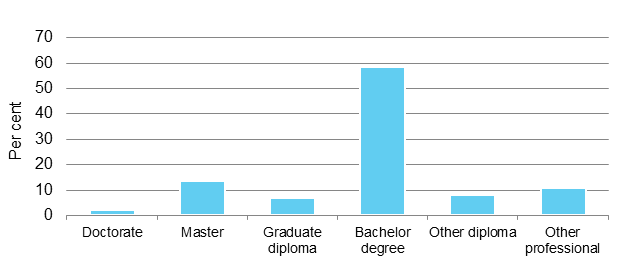
The most common field of qualification is what the Parliamentary Handbook categorises as ‘general’, which includes those degrees where the major field of study has not been specified (for example, Arts degrees and doctorates). Of the 362 qualifications, there were 96 in the ‘general’ category, 90 in law (a steep increase from 66 in 2005), 30 in economics/commerce, 25 in administration, 24 in education (a marked decline from 35 in 2005) and 13 in health (see Figure 5). In fields other than law and education, the fluctuations since 2005 are less pronounced.
Figure 5. Fields of qualification (percentage)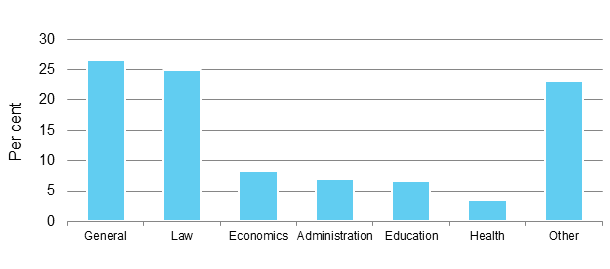
A breakdown of the fields of qualification by party reveals some differences (see Figure 6). In 2005 more Coalition members had law qualifications than their Labor counterparts (23 per cent to 18 per cent), but in the 43rd Parliament 27 per cent of Labor members had law qualifications, while the Coalition’s level of law qualifications remained at 23 per cent.
Figure 6. Fields of qualification, by party (percentage)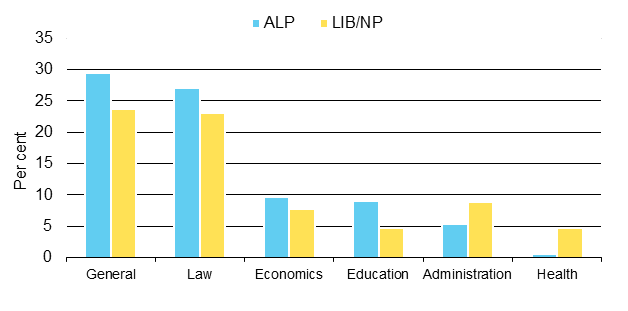
Career paths are often complex: a member with legal qualifications may initially practise law, and then later become a business executive or a union official. The Handbook data on the previous occupation of members of the 43rd Parliament describes the jobs they held immediately before their election to Parliament. It does not say how long members held these jobs before they entered parliament, nor does it include details of any earlier employment. (The latter can be found in the individual entries in the biographies section of the Handbook.) Details are provided in Table 2.
Table 2. Previous occupation
| |
Number
|
Percentage*
|
| Business executives, managers, self-employed businesspeople, company directors, etc. |
57
|
25
|
| Political consultants, advisers and lobbyists |
32
|
14
|
| Barristers, solicitors, lawyers, legal officers, etc |
30
|
13
|
| Party and union administrators |
22
|
10
|
| Party and union officials |
14
|
6
|
| Members of state/territory legislatures |
13
|
6
|
| Public service/policy administrators |
10
|
4
|
| Other administrators/consultants |
9
|
4
|
| Farmers, graziers and other (full-time) primary producers |
8
|
4
|
| Researchers, research assistants, electorate and project officers |
8
|
4
|
| Lecturers, teachers, tutors |
5
|
2
|
| Medical practitioners, dentists, nurses |
4
|
2
|
| Local government officials |
3
|
1
|
| Other |
11
|
5
|
| Total |
226
|
100
|
* percentage of the total parliament
The 43rd Parliament included 30 people who worked in the legal profession, 57 who were in business, eight who were in the farming industry, and 92 who worked in politics-related jobs. The latter category includes local government officials, those who worked for a party or union, or a political lobbying or consultancy firm, or in a political research or electorate office position. This group amounts to 41 per cent, an increase of 15 percentage points since 1988, when the figure was 26 per cent.
The statistics for previous employment by chamber indicate those who have been ‘party and union administrators and officials’ were much more prevalent in the Senate: 26 per cent of senators held such jobs immediately before entering parliament compared with only 11 per cent of lower house members (see Figure 7; for the purposes of this comparison, some of the employment categories have been conflated). ‘Business executives, managers, etc.’ were more likely to hold seats in the lower house.
There were substantial differences in the backgrounds of Labor and Coalition members (see Figure 8), most notably in the categories of ‘party and union administrators and officials’ (predominantly Labor) and ‘business executive/managers etc.’ (predominantly Coalition).
Occupations which have seen the largest increase represented in Parliament are: political consultants and advisers (from 2 per cent in 1988 to 14 per cent in 2011); and business executives and managers (from 17 per cent in 1988 to 25 per cent in 2011).
Occupations which have seen the largest decrease represented in Parliament are: lecturers and teachers (from 12 per cent in 1988 to 2 per cent in 2011); and farmers and graziers (from 8 per cent in 1988 to 3 per cent in 2011).
Figure 7. Occupation, by chamber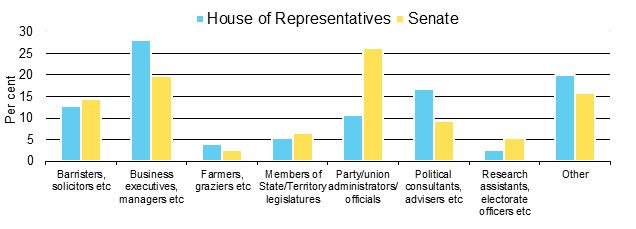
Figure 8. Occupation, by party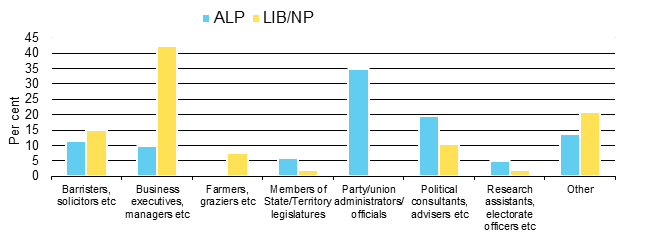
The first federal Parliament in 1901, not surprisingly, drew heavily on the experience of those who had served in state parliaments. Seventy-nine per cent of the first Parliament’s members and senators were previously in a state parliament.[11] This figure has dropped steeply since Federation. Among those elected from 1902 to 1948, 37 per cent were former state MPs; and among those elected from 1949 to 1980, 14 per cent were former state MPs.[12] In the 21st century, the number continues to decline: eight per cent of the 43rd Parliament were former state MPs. The movement of former federal members to state parliament is less frequent, with no obvious trends over time.
Local government service continues to play a significant role in the career path of federal members. In 1986 political historian Joan Rydon observed:
at one extreme [local government service] may be regarded as a training ground in politics…at the other it may be little more important than any other local activity or community service which contributes to public prominence and popularity’.[13]
Approximately 30 per cent of the first Parliament served in local government.[14] This figure, like the percentage of state MPs, has also declined over the years, but not as dramatically. The figure dropped to 19 per cent in 1980[15] and 15 per cent in the 43rd Parliament.
As at 1 July 2011, of the 226 members of the 43rd Parliament, nearly two-thirds (148 MPs or 65 per cent) had served less than 12 years; 45 members (20 per cent) had served less than three years (see Figure 9).
Figure 9. Length of service, total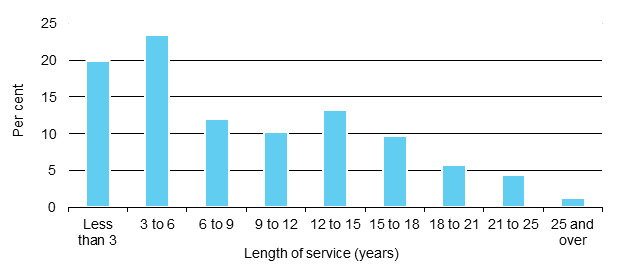
The longest serving members of the 43rd Parliament are listed below in Table 3.
Table 3. Longest serving members of the 43rd Parliament
| |
Senate
|
House of Representatives
|
| *Philip Ruddock (LIB, Berowra, NSW) |
|
from 22.9.1973
|
| ǂSenator Ron Boswell (NATS, Qld) |
from 5.3.1983
|
|
| ǂHarry Jenkins (ALP, Scullin, Vic) |
|
from 8.2.1986
|
| Bronwyn Bishop (LIB, Mackellar, NSW) |
11.7.1987–24.2.1994
|
from 26.3.1994
|
| Warren Snowdon (ALP, Lingiari, NT) |
|
11.7.1987–2.3.1996
and from 3.10.1998
|
| Senator John Faulkner (ALP, NSW) |
from 4.4.1989
|
|
| ǂSimon Crean (ALP, Hotham, Vic) |
|
from 24.3.1990
|
| Laurie Ferguson (ALP, Werriwa, NSW) |
|
from 24.3.1990
|
| Daryl Melham (ALP, Banks, NSW) |
|
from 24.3.1990
|
| Bruce Scott (NATS, Maranoa, Qld) |
|
from 24.3.1990
|
| ǂAlex Somlyay (LIB, Fairfax, Qld) |
|
from 24.3.1990
|
| Warren Truss (NATS, Wide Bay, Qld) |
|
from 24.3.1990
|
* Father of the House (the longest continuous serving Member of the House of Representatives)
ǂ did not contest 2013 election
The length of service in each chamber is similar with some occasional fluctuations (see Figure 10).
Figure 10. Length of service, by chamber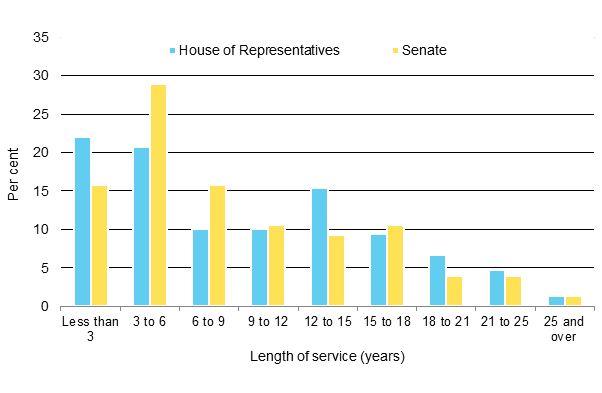
Examining length of service by party, notable differences can be observed in the ‘three to six years’ and ‘less than three years’ categories. These differences are consistent with the 2007 and 2010 election results and the respective swings to and from the ALP. Clearly a number of factors are at work in determining career length, perhaps most obviously, electoral success and the prospect of being in government and/or the executive.
Figure 11. Length of service, by party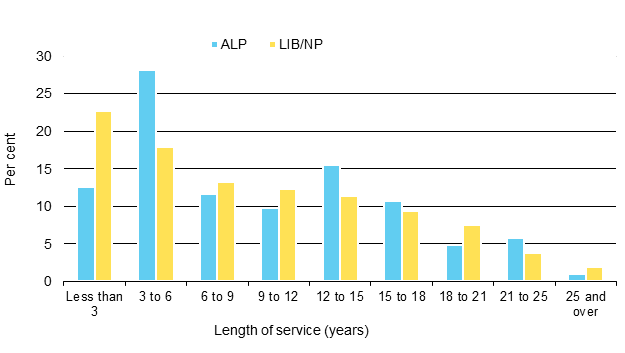
For those MPs elected between 1901 and 1909 the average completed length of service was 10.6 years.[16] This of course includes many MPs who had previously served in state parliament. For those elected between 1949 and 1954 the average completed length of service rose to 14.1 years. [17] More recently, between 2000 and 2012 the average completed term dropped to 13 years—12.6 years for members of the House of Representatives and 14 years for senators. Therefore there has been a slight if not substantial reduction in length of service. Given the increased ‘professionalisation’ of politics[18] and given that many MPs have served an apprenticeship in politics-related positions before entering the chamber, the era of the career politician is not over.
A comparison with similar statistics compiled in other countries suggests these demographic trends are not unique to Australia, although there are interesting differences:
- the percentage of women in Parliament in Australia (30 per cent) is substantially higher than either the United Kingdom (22 per cent) or the United States (18 per cent), but far less than countries such as Rwanda (52 per cent), Cuba (49 per cent) and Sweden (45 per cent)[19]
- the United States, Canada and Ireland, like Australia, have a higher proportion of women in the upper house,[20] but this is by no means a global trend
- the average age of Australian MPs (51) is comparable with that of the House of Commons in the United Kingdom (50)[21] and Canada (52),[22] but considerably younger than the average age of Members of the United States Congress (57 in the House, 62 in the Senate)[23]
- average length of completed parliamentary terms in Australia between 2000 and 2013 was double that of the Canadian Parliament—12.6 years in the House of Representatives compared with six years in Canadian House of Commons; 14 years in the Senate compared with 7.6 years in the Senate of Canada[24]
- the percentage of post-secondary educated MPs in Australia (81 per cent) is not as high as that of the UK House of Commons (90 per cent)[25] or the US Congress (94 per cent)[26] and
- trends in occupational background are familiar: in Congress, law, public service/politics and business are the dominant professions.[27] In the UK House of Commons, there has been a significant rise in the number of MPs previously engaged in politics-related occupations.[28]
Consequently, to some extent the characteristics of the Australian Parliament reflect global trends in other parliaments.
The 43rd Parliament was prorogued on 5 August 2013. Twenty-five Members of the House of Representatives did not contest the 7 September election. This is the highest number of retirements in the House of Representatives at one election—the previous highest number was 21 in 2007. Similarly in the Senate, seven senators announced their impending retirement and a further three senators, David Feeney (ALP, Vic), Barnaby Joyce (NATS, Qld) and Matt Thistlethwaite (ALP, NSW) resigned to contest the House of Representatives. This is also comparable with 2007, which saw the departure of ten senators. With such a sizeable turnover, it will be interesting to examine the characteristics of the 44th Parliament, and to monitor its traits and trends. In 2006 it was observed that MPs were predominantly middle-aged, well-educated men, likely to have been employed in politics-related occupations, business or law before entering parliament.[29] The statistics indicate that for the 43rd Parliament this remained the case.
[4]. For detailed statistics and information on the representation of women in Australian parliaments, see Dr J McCann and J Wilson, Representation of women in Australian parliaments, Background note, Parliamentary Library, Canberra, 7 March 2012, accessed 1 August 2013.
[7]. This figure is based on information obtained from published biographical information and first speeches in Parliament.
[8]. J Rydon, A Federal Legislature: The Australian Commonwealth Parliament 1901–1980, Oxford University Press, Melbourne, 1986, pp. 47–49.
[9]. J Rydon, op. cit., p. 156.
[10]. Fellowships, memberships, and associates of professional or other bodies are not counted.
[11]. J Rydon, op. cit., p. 91.
[13]. J Rydon, op. cit., p. 103.
[16]. J Rydon, op. cit., p. 58.
[19]. Inter-Parliamentary Union (IPU), Women in national parliaments, IPU website, 1 July 2013, accessed 1 August 2013. The individual chambers of bicameral Parliaments have been combined for ease of comparison.
[24]. Statistics provided by C Kam and F Pinar, Dept of Political Science, University of British Columbia, Vancouver, Canada, calculated from data published on the Parliament of Canada website, accessed 23 September 2013.
[26]. JE Manning, op. cit.
[29]. S Miskin and M Lumb, op. cit.
For copyright reasons some linked items are only available to members of Parliament.
© Commonwealth of Australia
In essence, you are free to copy and communicate this work in its current form for all non-commercial purposes, as long as you attribute the work to the author and abide by the other licence terms. The work cannot be adapted or modified in any way. Content from this publication should be attributed in the following way: Author(s), Title of publication, Series Name and No, Publisher, Date.
To the extent that copyright subsists in third party quotes it remains with the original owner and permission may be required to reuse the material.
Inquiries regarding the licence and any use of the publication are welcome to webmanager@aph.gov.au.
This work has been prepared to support the work of the Australian Parliament using information available at the time of production. The views expressed do not reflect an official position of the Parliamentary Library, nor do they constitute professional legal opinion.
Feedback is welcome and may be provided to: web.library@aph.gov.au. Any concerns or complaints should be directed to the Parliamentary Librarian. Parliamentary Library staff are available to discuss the contents of publications with Senators and Members and their staff. To access this service, clients may contact the author or the Library‘s Central Entry Point for referral.